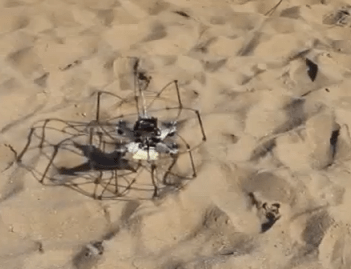The HyTAQ (Hybrid Terrestrial and Aerial Quadrotor) robot developed at Illinois Institute of Technology (IIT)
Ever since the Huygens probe landed on Titan back in January 2005, sending us our first tantalizing and oh-so-brief glimpses of the moon’s murky, pebbly surface, researchers have been dreaming up ways to explore further… after all, what’s more intriguing than a world in our own Solar System that’s basically a miniature version of an early Earth (even if it’s quite a few orders of magnitude chillier?)
Many concepts have been suggested as to the best way to explore Titan, from Mars-style rovers to boats that would sail its methane seas to powered gliders… and even hot-air balloons have been put on the table. Each of these have their own specific benefits, specially suited to the many environments that are found on Titan, but what if you could have two-in-one; what if you could, say, rove and fly?
That’s what this little robot can do.
Designed by Arash Kalantari and Matthew Spenko at the Robotics Lab at Illinois Institute of Technology, this rolling birdcage is actually a quadrotor flying craft that’s wrapped in a protective framework, allowing it to move freely along the ground and then take off when needed, maneuvering around obstacles easily.
A design like this, fitted with scientific instruments and given adequate power supply, might make a fantastic robotic explorer for Titan, where the atmosphere is thick and the terrain may range from rough and rocky to sandy and slushy. (And what safer way to ford a freezing-cold Titanic stream than fly over it?)
Also, the robot’s cage design may make it better suited to travel across the frozen crust of Titan’s flood plains, which have been found to have a consistency like damp sand with a layer of frozen snow on top. Where wheels could break through and get permanently stuck (a la Spirit) a rolling cage might remain on top. And if it does break through… well, fire up the engines and take off.
The robot (as it’s designed now) is also very energy-efficient, compared to quadrotors that only fly.
“During terrestrial locomotion, the robot only needs to overcome rolling resistance and consumes much less energy compared to the aerial mode,” the IIT website notes. “This solves one of the most vexing problems of quadrotors and rotorcraft in general — their short operation time. Experimental results show that the hybrid robot can travel a distance 4 times greater and operate almost 6 times longer than an aerial only system.”
Of course this is all just excited speculation at this point. No NASA or ESA contracts have been awarded to IIT to build the next Titan explorer, and who knows if the idea is on anyone else’s plate. But innovations like this, from schools and the private sector, are just the sorts of exciting things that set imaginations rolling (and flying!)
Color view of Titan’s surface, captured by the Huygens probe after landing in January 2005. (NASA/JPL/ESA/University of Arizona)
Video by RoboticsIIT


